Volcanoes seem like a distant reality, not something that could affect us here in this day and age. But the feeling is misleading because volcanoes rumble to life regularly. In fact, the islands of Hawaii currently have six active volcanoes. The string of islands was actually formed from volcanoes over time, many of which are now dormant.
In Hawaii, it’s normal to walk over the sleeping giants, as the volcanoes formed the islands’ lands and gave them substance. Volcanoes are a raw example of nature’s power. The islands of Hawaii are a manifestation of that power, all being fully formed from underwater volcanoes that slowly merged upward to create the land they now occupy. We’ll delve into the 6 active volcanoes in Hawaii and answer some basic questions about these living bits of history.
The Six Active Hawaiian Volcanoes
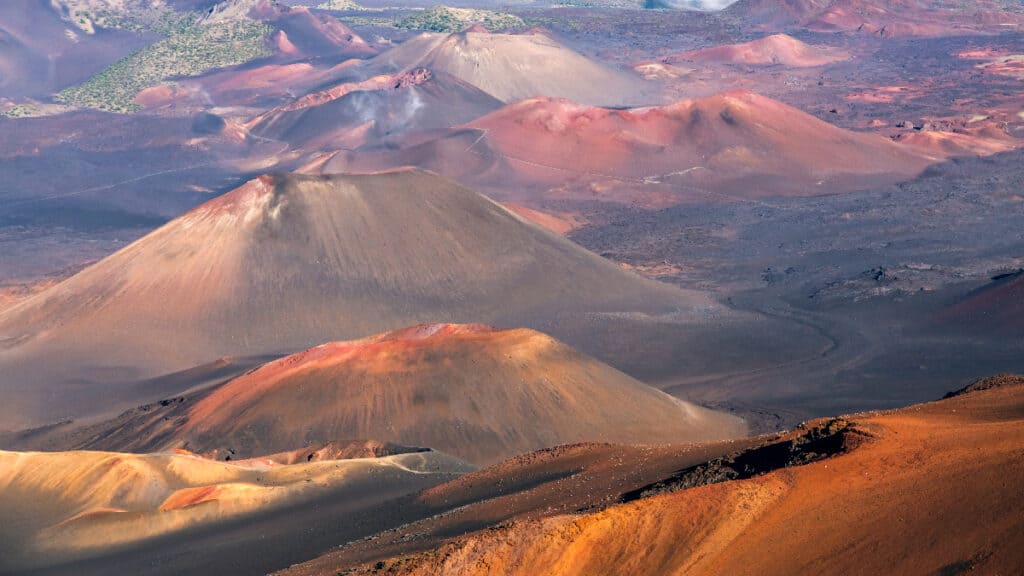
Haleakalā of Maui is one of the 6 active volcanoes in Hawaii
©topseller/Shutterstock.com
Hawaii is an archipelago including eight major islands. The Island of Hawai’i itself, often called “The Big Island,” contains the most of active volcanos of any of the islands. There are 15 main volcanoes in Hawaii, but 6 of them are active. The 6 active volcanoes in Hawaii are:
- Haleakalā
- Hualālai
- Kama‘ehuakanaloa
- Kīlauea
- Mauna Kea
- Mauna Loa
Not all of these volcanoes have erupted in recent years. Mauna Kea last spewed out magma 4,000 to 6,000 years ago and reclaimed the earth with its dense material. Mauna Loa, however, is the largest volcano on earth and erupted as recently as 1984. That volcano, along with Kīlauea, which erupted in 2021, are the two most active and well-known volcanoes in Hawaii, mainly because they make up the main Island of Hawai’i and are so strong. Before we discuss the 6 active volcanoes in Hawaii, let’s first describe the five main types of volcanoes.
Types of Volcanoes
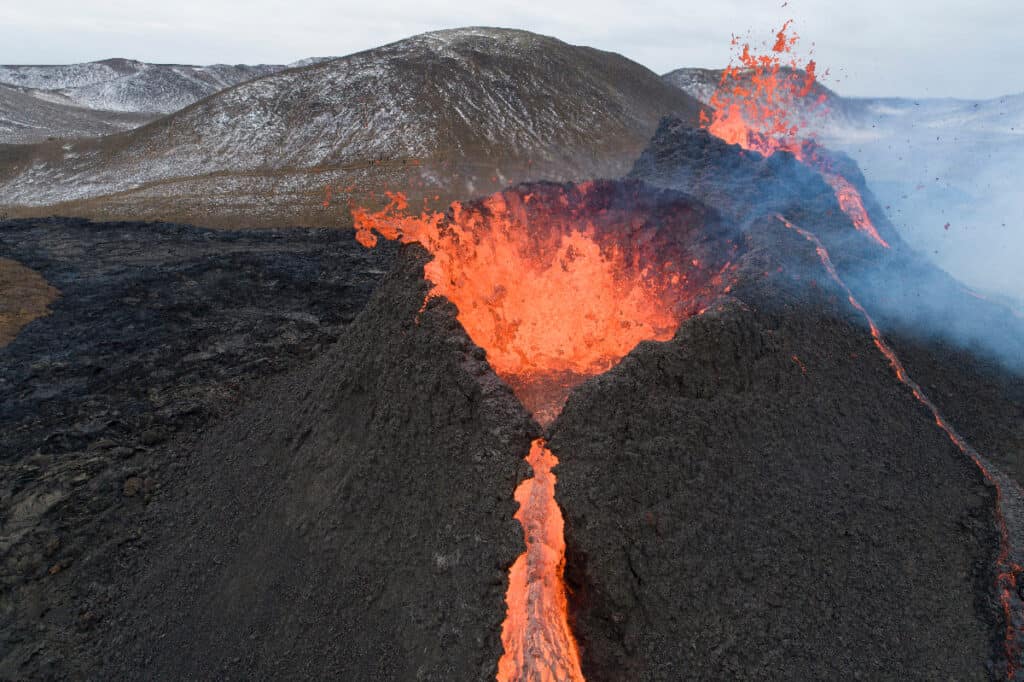
There are five different main types of volcanoes
©Cavan-Images/Shutterstock.com
It is essential to understand different types of volcanoes to discuss the main active volcanoes in Hawaii. This way, you can picture the volcanoes and better understand their relation to the world.
- Cinder Cone Volcanoes: These volcanoes are built up of the pyroclastic fragments they shoot while erupting. They grow upward and have a dip like a bowl for a crater.
- Complex Volcanoes: These volcanoes tend to form over another, smaller type of volcano. Over time, the volcano’s vent can shift and then a complex volcano forms.
- Composite/Strato-Volcanoes: These volcanoes grow when lava escapes different areas and stretches the volcano outward. Older volcanoes are often strato-volcanoes because they take thousands of years to grow.
- Shield Volcanoes: These volcanoes are smaller and spread further outward as the lava erupts and stretches their domain; these are the most common type of volcanoes.
- Spatter Cone Volcanoes: SImilar to cinder cone volcanoes spatter cones are formed up of the pieces they erupt. But instead of loose pyroclastic fragments, there are bits that become welded together from the heat that build up on top of one another.
Haleakalā

Haleakalā, pronounced “hah-le-ah-kah-lah,” is a shield volcano located on the island of Maui
©iStock.com/Ed Lallo
Haleakalā, pronounced “hah-le-ah-kah-lah,” is a shield volcano located on the island of Maui. Its name means “House of the Sun.” Of the five volcanoes on the island of Maui, this is the only one that is dormant and not dead. It’s believed that this volcano erupted around 400-600 years ago. While dormant now, it could erupt again at any time. Haleakalā is a shield volcano that pushes lava outward and over the lands. That is how many islands are formed, they start out as shield volcanoes and build up over thousands of years.
You can visit this gorgeous volcano within a National Park. It’s about a 4-hour drive up to the tippy top, and it is incredibly worth it to visit this beautiful sleeping giant. The National Park website boasts a beautiful walk through sub-tropical rainforests up the mountain, which is one way to witness the natural beauty of the island of Maui.
Hualālai
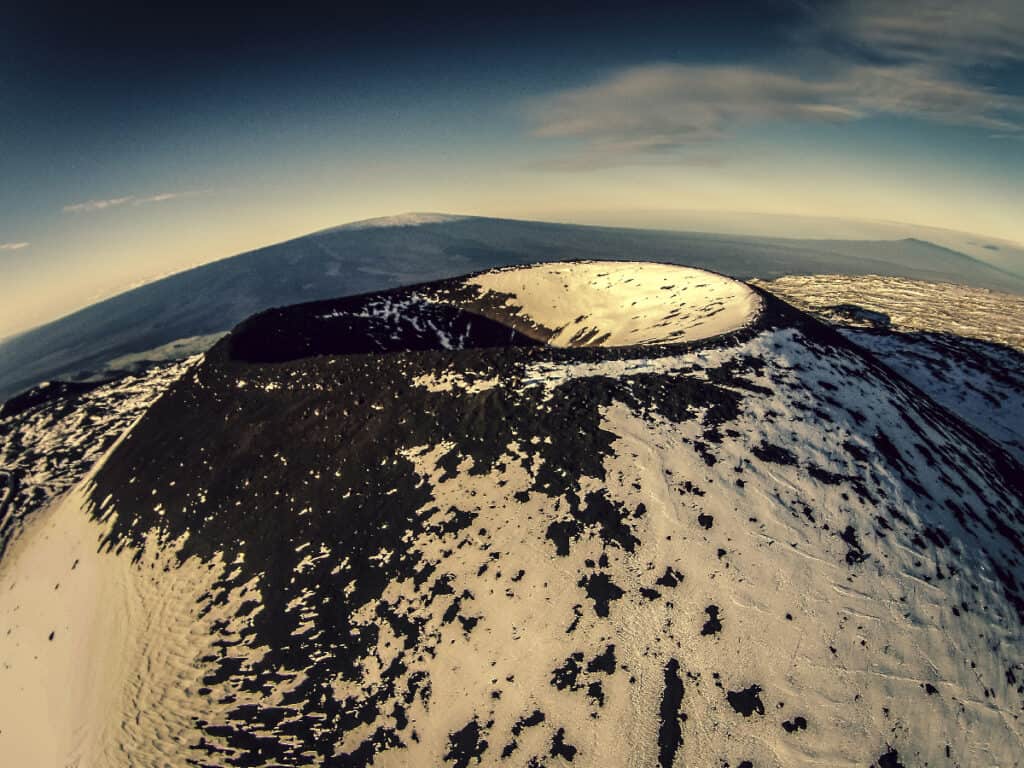
The Hualālai mountains can be seen in the background from a cinder cone on the summit of Mauna Kea
©iStock.com/krisbasonphotography
This volcano seems to rule by the power of threes as it is the third most active volcano among this chain, and also the third youngest. There are three recorded eruptions from it in the last 1,000 years. Hualālai, pronounced “Hua-l-a-lai,” erupted in 1801. More than 200 years have passed since then, so wouldn’t you think it’s due for an eruption. The last eruption had lava spooling out into the ocean, and it’s now beneath the Kona International airport.
This volcanoes name means “to sparkle or shine,” and it’s easy to see how it could be seen as sparkling or shining beneath a setting sun with lava flowing. It’s another example of a shield volcano. Since it is so young, it’s still a shield volcano, but it can grow and change over time. It’s guaranteed to grow and merge at some point, but scientists cannot accurately predict when that will happen.
Hiking and tours are allowed on Hualālai, though people often choose the other well-known volcanoes to traverse. There is a hidden loveliness in taking the path less traveled, so those who choose to be near this volcano will not be disappointed.
Kama‘ehuakanaloa
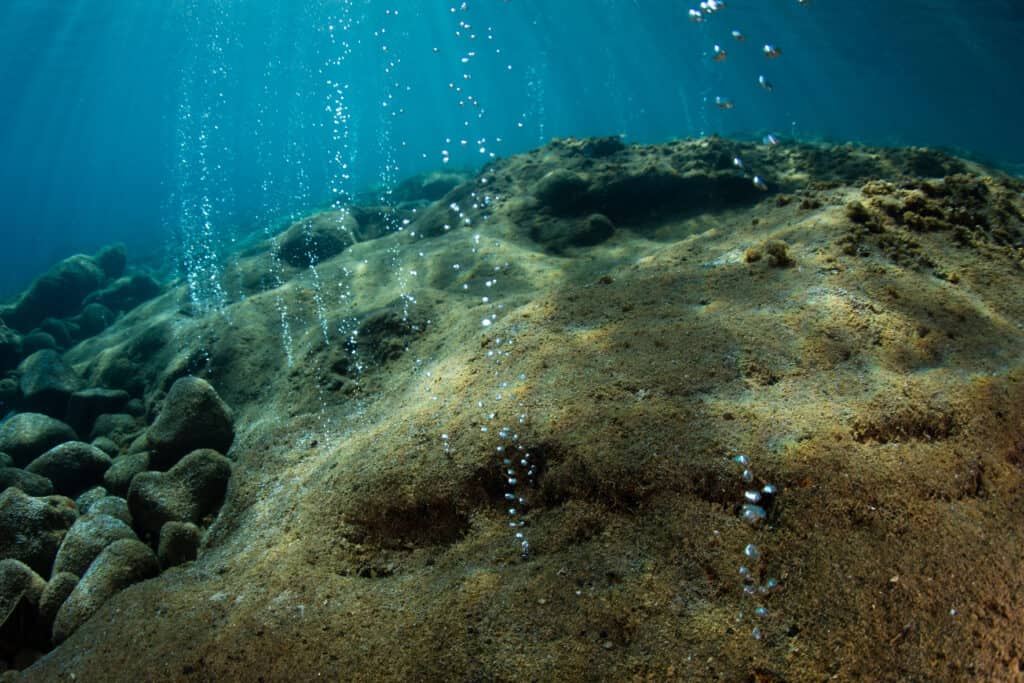
Volcanic gas bubbles rise from the ocean floor
©Ethan Daniels/Shutterstock.com
Another brilliant volcano we need to look at is Kama‘ehuakanaloa (formerly Loihi), located beneath the ocean waters. This underwater volcano is near another one we will be looking at called Mauna Loa.
All volcanoes start deep below ground, many of them underwater. Their eruptions over thousands of years grow them up and beyond, forming landmasses. Not all mountains were originally volcanoes, but many are, and it’s fascinating to consider.
Kama‘ehuakanaloa is one of the most active volcanoes in the world. You just don’t see it as much because it’s more than two miles beneath the water. There are three craters for this volcano and possibly a long magma section beneath them.
Last known to erupt in 1996, this volcano had its name changed from Loihi seamount to its indigenous name of Kama‘ehuakanaloa, most commonly referred to as Kanaloa. It means “child of the ocean” referring to it being an undersea volcano.
Kīlauea
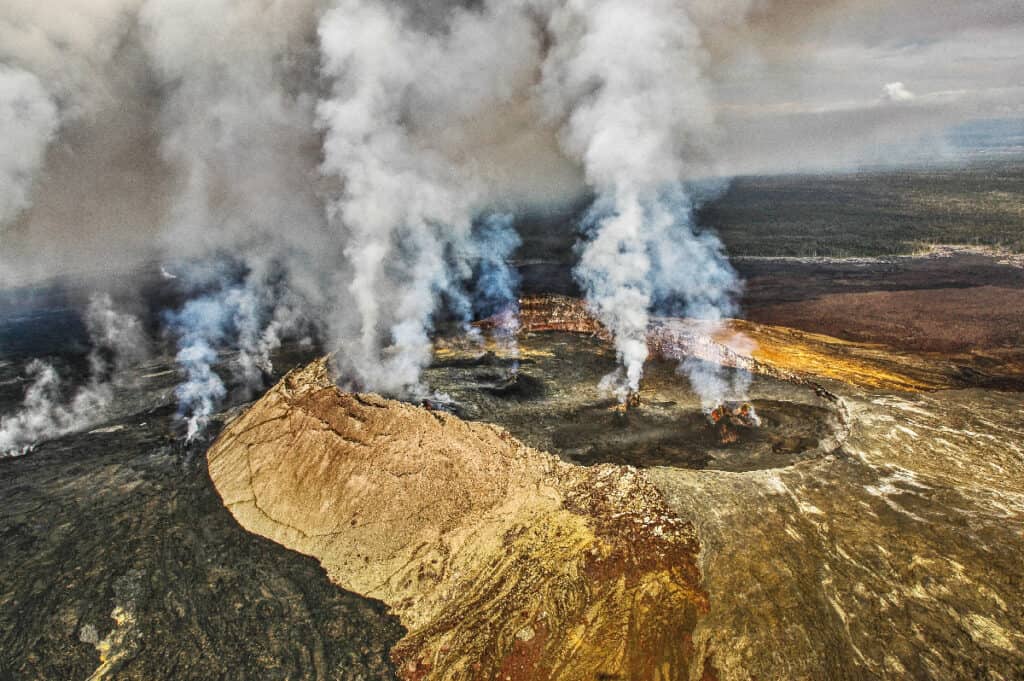
Kīlauea is the most active volcano in the world
©iStock.com/Vito Palmisano
Kīlauea is one of the top two active volcanoes in Hawaii, located on the Island of Hawai’i. It is thought that Kīlauea is the most active volcano on earth. Kīlauea is pronounced “kee-lou-ey-ah” and means “spewing” since it is constantly spewing molten rock from its many orifices.
The volcano Kīlauea has been erupting on and off since 1983. It’s known as a shield volcano, meaning it is not very tall but extends outward in a shield shape with slow-flowing lava. Video from the most recent eruption, September 2021, shows a beautiful array of red and orange lines spilling outward, forming new layers to the shield volcano of Kīlauea.
Kīlauea itself is the youngest volcano among the islands and is made primarily of the lava flow that has come about in the last 1,000 years. In comparison, most other volcanoes are built up of lava flow from four thousand years ago or more.
This constantly erupting volcano has more than twenty craters. To see it from above, the red lines of lava crisscrossing over the old blackened ground is magical.
Mauna Kea
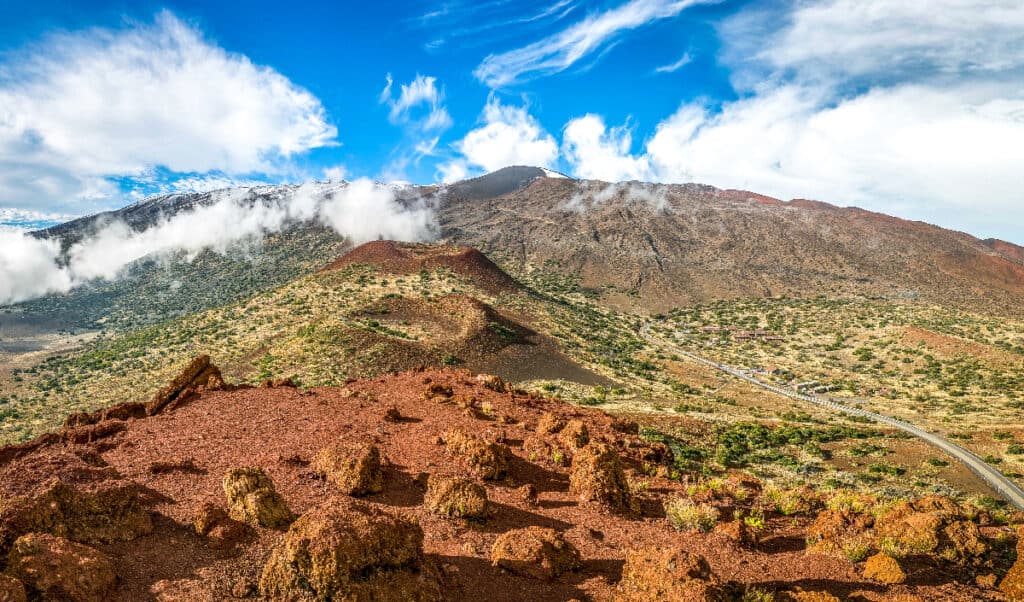
Mauna Kea is the highest volcano on the Big Island of Hawaii
©Mason Lake Photo/Shutterstock.com
Mauna Kea means “white mountain” and refers to the fact that the summit of this magnificent volcano had glaciers atop it when we had our last ice age. This is the highest volcano on the Island of Hawai’i and has not erupted in the previous 6,000 years.
This is another shield volcano that has been around for many years. Beginning as an underwater volcano, it’s been slowly growing to help build the Island of Hawai’i and take its title as the tallest volcano on the island.
The summit of Mauna Kea can be visited, but the observatories are not currently open to the public as of 2022. This volcano can only be traversed during the daytime as it is so large and could become dangerous to navigate at night.
Mauna Kea extends 6000 feet below sea level and 4000 feet above, a fantastic feat for a shield volcano. Even though it doesn’t appear to be the tallest above ground, its roots are deep beneath us.
Mauna Loa
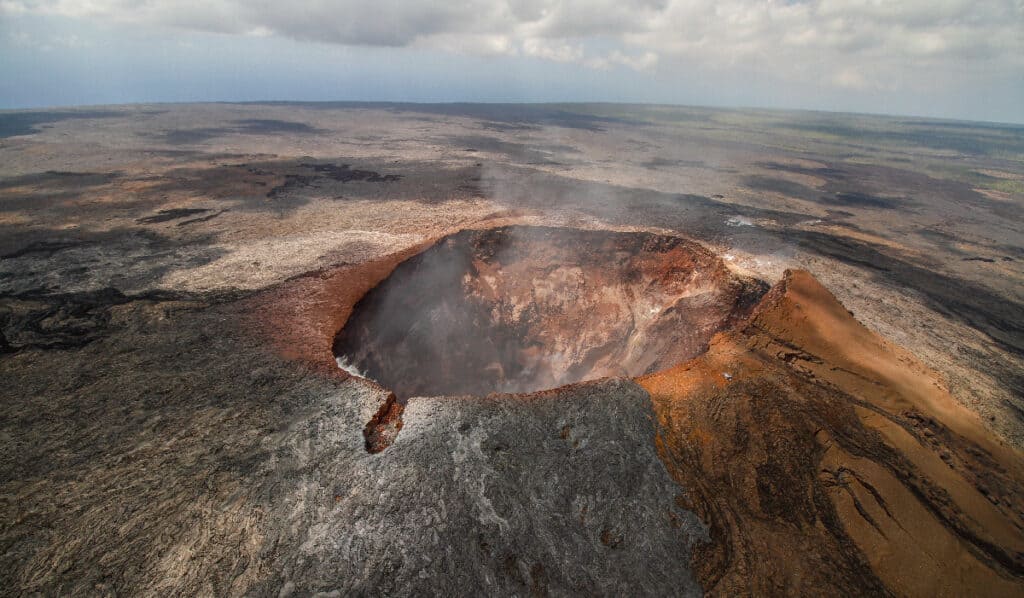
You can visit and walk to the summit of active volcano Mauna Loa
©iStock.com/CStorz
Last, but certainly not least, is Mauna Loa, covering half of the leading Hawaii island. It has erupted 33 times since 1843 and is one of the most active volcanoes on Earth. Every eruption sets a beautiful tableau on Hawaii, both terrifying and beautiful all at once.
Most of this volcano is covered in lava flows in more recent years. Being active means this volcano is quite famous. Walking or biking up and around Mauna Loa and its summit is possible. There’s always a slight risk that it could begin to erupt, which is part of the excitement.
Mauna Loa stands for “long mountain,” which is because it’s a long spread out mountain, as are most shield volcanoes.
Hawaiʻi Volcanoes National Park
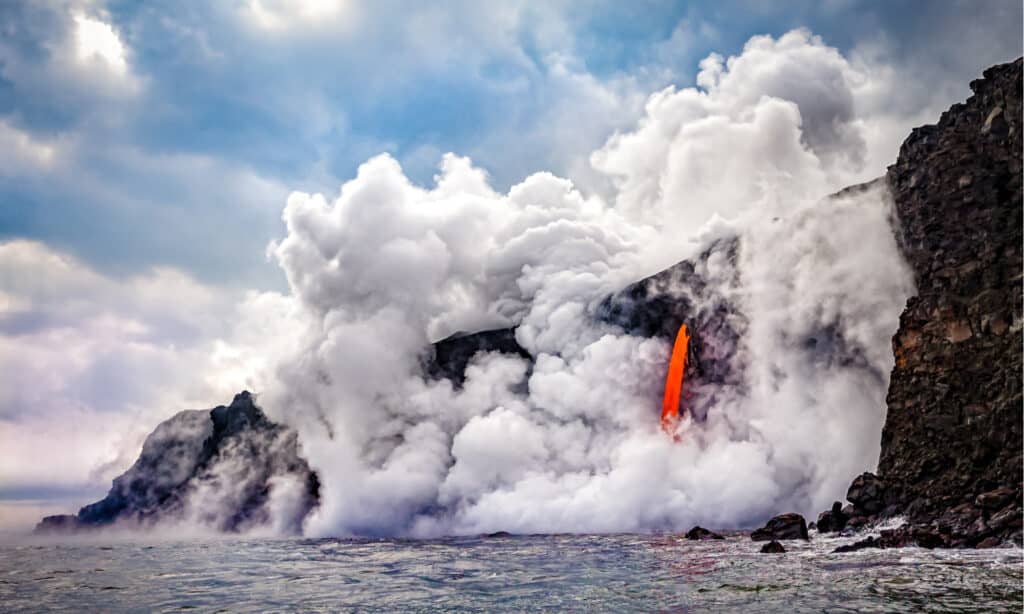
Kīlauea and Mauna Loa active volcanoes are at the heart of Hawaiʻi Volcanoes National Park
©jo Crebbin/Shutterstock.com
Hawaii Island contains the Hawaiʻi Volcanoes National Park. Kilauea and Mauna Loa are the active volcanoes featured here. These volcanoes, along with all the rest, bring a certain fierce charm to the islands of Hawaii. Over thousands of years, they have grown, destroyed, and birthed lands and civilizations. Witnessing this great act of both destruction and rebirth is awe-inspiring, and you’d be remiss not to take the chance to view an eruption if you have it.
The photo featured at the top of this post is © Gary Gilardi/Shutterstock.com
Thank you for reading! Have some feedback for us? Contact the AZ Animals editorial team.







